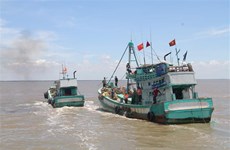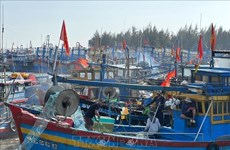Delegates from OANA members visit Ha Long Bay
 Delegates from OANA members are on a ship to visit Ha Long Bay (Photo: VNA)
Delegates from OANA members are on a ship to visit Ha Long Bay (Photo: VNA)Quang Ninh (VNA) – Delegates who have been in Vietnam to attend the 44th Executive Board Meeting of the Organisation of the Asia-Pacific News Agencies (OANA) on April 20 visited Ha Long Bay, a UNESCO world heritage site in the northern province of Quang Ninh.
Quang Ninh is home to more than 2,000 islands along its 250km-long coast. Notably, its Ha Long Bay features 1,969 islands and islets covering 1,553 sq.km. The bay was recognised as World Natural Heritage by UNESCO in 1994 and 2000. It was also selected one of the new seven wonders of nature in 2011.
The bay features thousands of limestone karsts and islets in various shapes and sizes. The limestone in the bay has gone through 500 million years of formation in different conditions and environments. The geo-diversity of the environment has created biodiversity, including a tropical evergreen biosystem, oceanic and sea biosystem. Ha Long Bay is home to 14 endemic floral species and 60 endemic faunal species.
Mustafa Ozkaya, Deputy General Director of Turkey’s Anadolu Agency, said he was happy to visit Ha Long Bay and be warmly welcomed by local residents.Ozkaya said Ha Long Bay is one of the most beautiful places he has ever visited, and he would introduce it to Turkish people.
Meanwhile, OANA Secretary General Vugar Seidov recommended Quang Ninh popularise its world natural heritage to news agencies as well as people of other countries.
Promoting images is the best measure to promote tourism, and journalists are the best tool to carry out that promotion, he added.
The 44th OANA Executive Board Meeting was hosted by the Vietnam News Agency (VNA) in Hanoi from April 18-20 under the theme of “For a professional and innovative journalism”.
Quang Ninh is located in the northeast of Vietnam and has a total land and sea area of more than 12,000 sq.km. The province is described as a “miniature Vietnam” as it gathers all typical features of the country in terms of terrace, natural resources and landscapes.
It shares both land and sea border with China and is an important trading gateway of Vietnam with China and ASEAN countries.
In 2018, Quang Ninh welcomed about 12 million tourist arrivals with 43 percent of them foreigners, earning 24 trillion VND (over 1 billion USD) in tourism revenue, according to local authorities.
Along with Ha Long Bay, Quang Ninh is home many impressive landscapes such as Bai Tu Long Bay, Tuan Chau peninsula, Quan Lan, Co To islands, Yen Tu mountain and Tra Co beach.
Located in Tonkin Gulf in the northeast of Vietnam, Bai Tu Long Bay covers the waters of Ha Long and Cam Pha cities, and the island district of Van Don in Quang Ninh province. It includes hundreds of islets of all sizes, many big enough for habitation.
Bai Tu Long Bay is home to many traces of Ha Long Culture that dates back thousands of years.
It features limestone and schist islets – a result of geological formations lasting over 300 million years. Famous islets include Bai Tho, Con Coc, Tien Ong, Con Rua, Dam Oan, Mat Quy, and Con Co. Some outstanding caverns there are Thien Canh Son Carven, Tam Cung Cavern and Me Cung Cavern.
The bay also harbours beautiful beaches such as Con Co, Van Don, Quan Lan, Minh Chau and Co To.
Quan Lan Island is a must-visit destination for tourists to Bai Tu Long. It is suitable for adventurers as well as those who love simple and romantic experiences thanks to the harmony of sea, forest, culture and architecture.
Visitors can also tour the fishing village on Minh Chau Island or Cai Lang – the oldest village there.
Thong Thien Cave, Phat Co Island, and Ban Sen Island are among other destinations tourists should have a look at. Sailing to explore submerged forests or swimming in the clear water off Uyen Uong beach are recommended experiences.
Additionally, vacationers can visit Cua Ong Temple and Van Hoa port or walk through forests to experience the hospitality of ethnic Tay, Red Dao and San Diu people in their villages across Bai Tu Long Bay.-VNA













